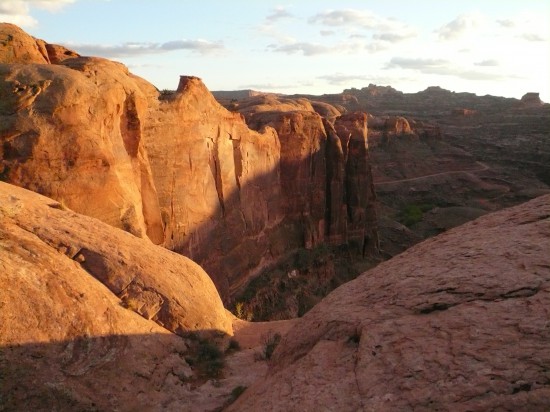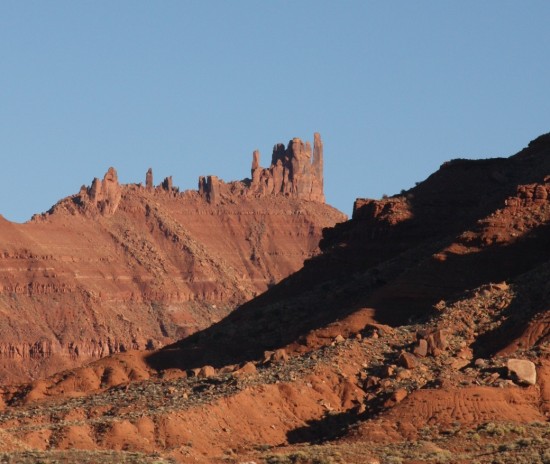Hello From the Navajo Nation
Ya ta hey Ms. Davis,
Hello from the Navajo Nation! I have been climbing for a good two years now and I can’t imagine my life without it. Besides climbing, the only other place I have found balance and peace is in our ceremonies.
I have one question: Do you practice any rituals or ceremonies before you climb a certain wall? I always ask for permission from the rock deities before I climb. I am just wondering if other climbers do similar things. Sorry, I didn’t mean to go “new age” on you. I would love to write about my experience as a Native Rock Climber down the road and I just want to hear what other people think.
I am nearing 40 and I feel fortunate that a co-worker introduced climbing to my wife and I three years ago. Now, I feel the need to pass it on to young native kids. I believe that indigenous outdoor education is a fun way to reintroduce our culture to this generation of native youth. I am looking to find a respectful way of introducing it to our elders before I fully commit to this project.
You are truly an inspiration. Please let me know if you plan to speak at any events soon. Thank you.
Brian K. Francis
Youth in Action AmeriCorps
Program Director
Northern Arizona University
Dear Brian,
Thanks very much for writing to me. I think your project of introducing native youth to rock climbing is a fantastic idea. I would be eager to help you with that, and I’m sure a lot of others would too. I also know that it’s crucial to have the support of the elders and the entire community for any undertaking, as you said. So if you find a way to start a program, please let me know how I could help or organize more help from the outdoor community.
I liked hearing that you talk to the rock deities before climbing. Whenever I get kind of serious about a climb (if it’s hard for me and it’s a project, or if it’s a free solo), I end up spending a lot of time on the rock. I usually spend a lot of time there alone, working on the route. And if it’s a long climb or long approach, I sleep at the base, on the wall or on top as well. For me, this is a very important and special part of working on a climb, getting to know it and spending time with it, and probably the main reason I like doing it. These cliffs become like a part of my family–for example, the Tombstone, a cliff about three miles from my house in Moab. I’ve spent a lot of time climbing on the Tombstone, and I base jump it several times a week, a lot of times by myself. I consider it a big part of my daily life.

So I’m always walking up to the top, looking at everything, noticing any little changes, sitting up there looking all around at the shadows and the canyons. There are always little lizards running around, and sometimes birds are playing in the updrafts at the top. I feel really connected to that cliff. If I’m climbing on a rock like that, one I have spent many days or even months and years of life with, I feel very close to the rock and to the route, and often just say thank you to it for letting me be there, whether I’m climbing or walking up or jumping down. Because I know how fast things can change and that at any moment I can be gone from there too. So I’m lucky to be able to be there, doing what I am doing. There are several cliffs and mountains in the world I feel that close to, because I’ve spent a lot of time with them, as much as the most important people and animals I have relationships with. In my mind, they are similar relationships.

A few weeks ago I did a free solo climb and base jump on a sandstone tower called Sister Superior, in Castle Valley, and all the way up the route I was asking the tower to let me be there, to be a respectful visitor in the cracks and to let me stay on the rock up and jump down safely. I was really appreciative that I could do that. Spending time in these rock walls, in an exposed way, makes me feel closer to them, like I also have a place there along with all the other animals who are crawling up and flying around them.
🙂 Steph








This particular blog exemplifies the difference between climbing and other sports. There is a connection of respect and admiration for the rock; and simultaneously a yearning to conquer it. Even at the top though, climbers realize that we really conquered nothing but ourselves and our own fears and what we thought our limitations were. The size and stature of the rock, even when standing on top and not daunted at the base, inspires humility.
Native Americans were the first to climb in that area, and I’m glad to see (even if only in a small way) that tradition and the climbing heritage of that area still lives. I enjoyed reading this and I applaud you, Brian, for your dedication and your effort to pass down something worth passing down to the next generation.
Steph,
Thank you so much for responding to my post. I am currently serving on a board for a program called Four Rivers Institute. Four Rivers is a program for native youth to reconnect with the outdoors. I will be in touch.
Brian
bkfrancis2003@yahoo.com
Jake,
Thanks for the encouraging words brother. Happy New Year!
Brian